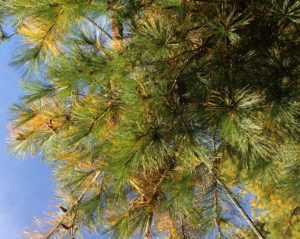Hello, fellow readers,
I always enjoy hiking along the Appalachian Trail with a longtime friend from Boonton, NJ. While meandering the rocky terrain peppered with hemlock and Spruce, Barbara asked why some trees remain evergreen and others don’t. Good question. Let’s ask the trees.
When daylight shortens, plants begin hunkering down.
During the growing season, leaves and needles photosynthesize to make food for the plant. Come fall, as daylight shortens, it signals plants to hunker down for winter. Deciduous trees cut off their leaves’ link to water and minerals and drop off after only one growing season.
Evergreen foliage, despite its name, doesn’t live forever. During the fall, older needles die and fall off as well. Pine trees hold their needles for two to five years or more, depending on the species. Spruces generally hold onto their needles for five to seven years. Hence, every autumn, some evergreen needles fall. However, the process often goes unnoticed because only the innermost needles are affected, except for Eastern White Pine (Pinus strobus), which are not shy about disrobing. They hold their needles for only two years and have an open structure and less growth at the tip of their branches to hide the needles as they undress.
Back to Barbara’s question about why some trees are evergreen.

Evergreen branches slowly bend down, layering on top of each other for protection “like tiles on a roof.”
Forester Peter Wohlleben writes in The Hidden Life of Trees why certain species live in certain areas, explaining a tree “can conquer enormous geographic range. And that’s basically what Spruce has done…. Spruces store essential oils in their needle and bark, which act like antifreeze. And that’s why they don’t need to jettison their green finery” in winter.
“As soon as the weather warms up in the spring, they can start photosynthesizing. Not a day is lost…” Unlike deciduous trees, of course, that need to grow new leaves before they can start their job of photosynthesizing
Hence, evergreens survive even in frigid regions of Siberia and Canada with very short growing seasons; not only that, they have fascinating “defense mechanisms” to protect them from snow and winds. Spruce trunks are usually straight, which keeps them in balance even with heavy loads of snow when branches gradually angle down until they are layered one on top of another “like tiles on a roof. Arranged like this, they mutually support each other,” Peter Wohlleben explains.
Should we worry about evergreen trees near our homes?

“It’s my fuzzy.”
Folks worry more about evergreen trees toppling in high winds with snow loads. Understandably so, given winters when we’ve endured nor’easter’s one-two-three punch. The thing is, spruces grow slowly for sure-footedness, “and statistically speaking, the danger of being blown over doesn’t increase significantly until the trees are more than eighty feet tall,” per Peter Wohlleben.
So, the question isn’t why some trees remain evergreen. It’s how. And “how” is the miracle of Nature’s resilience and ability to adapt, flourish, and provide respite for others. We have much to learn from trees. Garden Dilemmas? AskMaryStone@gmail.com and your favorite Podcast App.
There’s more to the story in the Garden Dilemmas Podcast, including coming upon this baby squirrel.
Link to a related story: Why Leaves Change Color 101





Doesn’t really answer the question you proposed
Hi Elizabeth, As Peter Wohlleben writes in The Hidden Life of Trees, why some trees remain evergreen is a mechanism to allow them to thrive in sometimes very tough environments as I reference in the post. Trees are fascinating! Thank you for taking the time to share and for reading my post, Mary